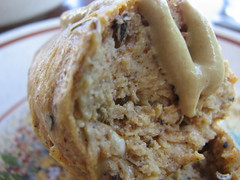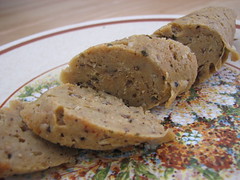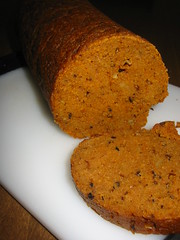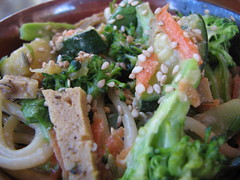July 17th, 2008
Sausage-fest
Vital wheat gluten is a wonderful thing. My first encounters with seitan (the wheat meat) were unflavored store-bought varieties over 10 years ago. This little gluten has come a long way from Chinese Buddhists of the past. While in culinary school I wanted to learn how to make it, the traditional way. One of my chef instructors knew how but laughed at me. I always wanted to use my spare time to do some “old-world” thing from scratch, no matter how long it took. Making seitan from bread flour takes a LONG time. Basically you put flour and water in a bowl and knead it until it’s like bread dough. Then you soak it in water, let it sit, knead and knead and rinse the starch away. It took about 3 hours, probably longer, but it came out just like the rubbery stuff that I knew. My goal that day was to grind it and make a vegan version of salisbury steak because I was assigned cow salisbury steak that day to learn to make. I have blacked out the entire meat side of the day and only remember kneading that doughy glutinous mass.
Knowing the labor involved in scratch-seitan, I am quite thankful for whoever thought to isolate the gluten from the flour and sell it in powdered form. Called vital wheat gluten and available in most supermarkets now, it takes the 3 hours kneading process down to 5 minutes or less. Plus by doing it this way you can add in lots of flavors that aren’t possible with homemade gluten. I have seen a lot of recipes calling for nutritional yeast, soy sauce and lots of spices in the mix, which really make it palatable for omnivores. There are many ways to cook it, from simmering on the stove (which makes it too spongy), braising in the oven (mixed results), wrapping in foil and baking it (for the seitan o greatness) or steaming it (Julie Hasson style). If your stove is finicky, I don’t recommend simmering it at all. I’ve tried all kinds of broths and flavoring agents but it doesn’t seem to soak in from the boil water. The best way to infuse flavor is directly into the mixture.
I am always experimenting with different seitan recipes and most recently made Julie Hasson’s Italian Sausage. I love that she adds chickpea flour to the dough, it seems to give it a great texture and flavor different than the others. My husband LOVED this sausage recipe and I will be playing around with it a bit. I didn’t have onion powder, smoked paprika or red pepper flakes so I used more Hungarian paprika and jalapeno flakes. I used a powdered chik’n broth from my co-op instead of what she recommended and it didn’t come out too salty. I also cheaped out and used less foil than she does in her video and some of them popped out of the package and are crazy shapes. It still tasted awesome. Moist, not too chewy and great flavors.
Last year, the Seitan O’Greatness was on a lot of food blogs and I too tried the recipe and found it easy to make and bake. This seitan is like a log of pepperoni, spicy, meaty and dry. I’ve also tried the Italian sausage from the Artful Vegan and liked that flavor combination a lot, although if I were to do it again, I would wrap it in foil and steam it, not simmer it in cheesecloth. Real Food Daily has an interesting seitin recipe that uses pureed beans in the mixture and it’s baked in a loaf pan. It tastes like pureed chicken and stuffing. It was much softer than the other seitans and not sliceable, but really tasty. I will have to make these recipes again and update with pictures.
The options to cook seitan are endless. We like to pan-fry and serve plain with dijon mustard if we’re feeling lazy. I’ve added it to tomato sauces, pasta dishes, grilled and eaten like a hot dog, cut up and put in burritos, or braised with sauerkraut if I want to feed my Polish cravings. I also like to cut it into strips and throw it into soup. I look forward to seeing more people develop new recipes and the continued improvement of this lovely hunk of protein.




